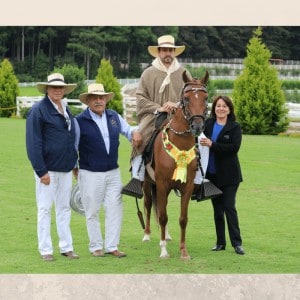 By Dr. Francisco Marcucci
By Dr. Francisco Marcucci
Dear reader for me it is a pleasant satisfaction to be back in these pages and be able to share my understanding of what has been the evolution in the upbringing of the Peruvian Paso breed. When I started as a breeder of the Peruvian horse several decades ago, the Peruvian paso horse was going through a normal selection process, carried out by breeders of that time in Peru.
On my first trip to Peru in 1982 I had the opportunity to be invited by for by the engineer Manuel Mazzi Casas, my teacher and friend. We went to visit several important breeding farms of the time, including the ranch of Mr. José Antonio Onrubia, José Antonio Otero, the Criadero Sierra Morena of the Srs. Bedolla, Joseph Musante H., José Risso Matellini, Alfredo Elias of Ica, Hugo Nieto, Nazario Villafuerte, Fernando Pescheira and some others that escape my memory.
In this way I was able to know many horses of that time that where I found individuals that differed in forms, colors, styles, and gait. Recognizing that in spite of this diversity, there were beautiful animals that had very good gaits. Having been able to perceive that there was a need for an adequate selection of the horses that would establish a uniformity in colors, format and function.
Fortunately this need of selection would have already begun to be given by the judges of that time, Don Antonio Grana and Don Fernando Grana, who established the guidelines for a better uniformity of format and function. They also tried to establish defined colors, punishing the escessive White, and in this way reducing excesses of White in the horses.
We can understand this was not an easy or pleasant task, somehow the breeders and the national association perceived the need for nurturing a collegiate body of judges who will continue with the selection and classification of the horses.
Within the group of breeders were the most suitable persons to form this entity. During my next visits to Peru I was able to observe the extraordinary work carried out by this group of breeders converted to judges. They established the basis for achieving in time the objectives that today have been obtained.
At present the national association has maintained within its committee of judges to people who have the skills needed for this important work and new judges have been formed under more professional systems to be able to perform properly and sustain their judgments.
In my opinion at the present time the Peruvian horses that are presented in the different shows are actually horses of high quality both in form and function, having formed the breed to an impressive uniformity. As a breeder of the Peruvian Horse, I am pleased that the breed has achieved the desired objectives and is continuing with the purpose to overcome them.
All of these qualities can be observed by the high degree of competitiveness that horses which are presented in shows possess.
Really I can tell you with full certainty that our horse is a natural work of art.
